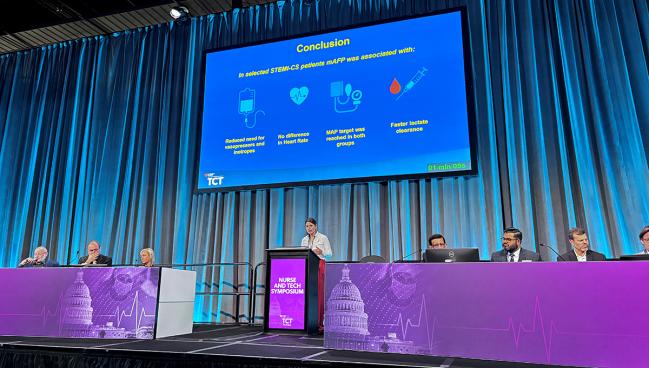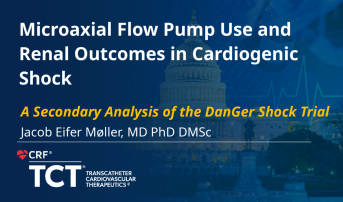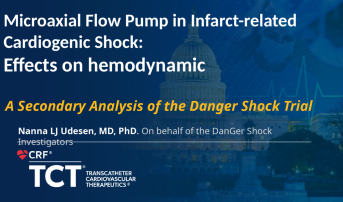New DanGer Shock Data: Hemodynamics, Renal Dysfunction, and Bleeding
Three secondary analyses clarified how the Impella pump works in STEMI with cardiogenic shock, and how things can go wrong.

WASHINGTON, DC—For patients who present with STEMI complicated by cardiogenic shock (STEMI-CS), it’s not news that the long-awaited DanGer Shock trial showed better 180-day survival after Impella CP (Abiomed) support compared with standard care. But what exactly is driving that benefit, as well as how complications make their mark, is still under study. Three secondary analyses released today at TCT 2024 provide some insights.
The data were presented in back-to-back presentations during a TCT WorldLink Forum session.
For the first, Nanna Louise Junker Udesen, MD, PhD (Odense University Hospital, Denmark), shared the findings related to the mechanisms behind Impella support. DanGer Shock principal investigator Jacob Eifer Møller, MD, PhD, DMSc (Odense University Hospital), in the next, delved into renal dysfunction. And finally, Lene Holmvang, MD, DMSc (Copenhagen University Hospital Rigshospitalet, Denmark), addressed bleeding events.
Møller, speaking with TCTMD after the session, condensed the wide-ranging analyses into several takeaways. Most fundamentally, he said, “the device works. . . . We’re clearing lactate and that’s so important for the patient. It’s the driver of mortality, and it’s really comforting to understand that some of the effect is related to this.”
The data argue, too, that clinicians on the shock patient’s care team should be alert to risk factors for complications and heed the warning signs, like suction alarms, when they occur, Møller stressed. “If you are not treating these patients regularly, you will not take the ‘yellow’ alarms that seriously and then the trouble will begin,” he said, adding that the solution is “training, training, training.”
No doubt much more learning, and more data, are on the way. In the wake of DanGer Shock, many in the field wondered what would come next. The premature termination of the RECOVER IV trial was the first fallout. At the time, cardiologists reacted to the news that less information would be forthcoming with a mixture of disappointment and grim acceptance. The new analyses presented Sunday at TCT, however, suggest that there’s not only more to glean from the existing dataset, but also actionable insights for future research.
What Drives the Benefit?
Udesen et al’s analysis explored Impella’s hemodynamic and metabolic effects and was published simultaneously in JAMA Cardiology.
“It’s crucial to understand how this pump works,” Udesen told TCT attendees.
Investigators, after excluding patients who died in the cath lab or died immediately upon admission to the ICU, focused on the 324 individuals (mean age 68 years; 80% male) in the 355-participant trial who underwent serial recordings of hemodynamics, arterial lactate, and use of vasoactive drugs during their ICU stay. Fifty-two percent had been assigned to Impella CP and 48% to usual care.
Baseline heart rate was similar in the Impella and control groups, then declined to the same degree in each over the course of ICU management. Mean arterial pressure (MAP) was initially higher, at 1 hour and 12 hours after admission, for the Impella-assigned patients than for controls, but levels were similar in the two thereafter.
“A difference in the vasoactive strategy to achieve hemodynamic targets was noted between the groups, both in the use of inodilators and vasopressors,” the paper notes. In the standard-care patients, “vasopressors were generally initiated before inodilators,” peaking at 6 hours versus 12 hours, respectively,” the authors report. In the Impella patients, “the increase in both vasopressors and inotropes was delayed and first seen after 24 hours.”
While arterial lactate level was similar at randomization, by the time patients arrived at the ICU, the Impella group had significantly lower lactate compared with controls (mean difference 1.3 mmol/L), which then persisted within the first 24 hours of observation. Impella-treated patients saw their lactate normalize (< 2 mmol/L), on average, 12 hours faster compared with standard-care patients.
“Results of this substudy of the DanGer Shock randomized clinical trial suggest that use of an [Impella] microaxial flow pump reduced the use of vasopressors and inotropes while maintaining hemodynamic stability and achieving faster normalization of lactate level,” the authors conclude. “Although MAP remained above the 65-mm Hg treatment target in both groups, it was achieved with [less medication] in the microaxial flow pump group, thereby highlighting the ability of the device to sustain blood pressure with less pharmacological intervention.”
The Impact on Kidney Health
Shifting the topic to renal dysfunction, Møller shared data that were published simultaneously in Circulation, with lead author Elric Zweck, MD (University Hospital Düsseldorf, Germany).
“What I’m going to focus on is this signal we saw that there [was] more kidney injury in patients on the device, which surprised us when we started to dig into the data,” said Møller. Earlier this spring, when the main DanGer Shock results were released, researchers had reported a higher rate of renal replacement therapy [RRT] in the Impella group compared with controls (42% vs 27%; P < 0.01).
This new analysis confirms “this risk is real. There is more kidney injury in the patients on microaxial flow pump,” he said, adding, “AKI is not benign—it’s associated with increased risk, so we have to take this seriously.”
Among the 355 STEMI-CS patients randomized in DanGer Shock, 61% of those allocated to Impella CP and 45% of those allocated to standard care ultimately developed AKI, defined as RIFLE ≥ 1. For patients who received RRT, two-thirds did so within the first 24 hours of admission.
AKI was linked to higher 180-day mortality in both the Impella group (54% vs 33%; P = 0.008) and the control group (68% vs 51%; P = 0.017), as was RRT (56% vs 38%; P = 0.020 with Impella and 74% vs 53%; P = 0.010 with standard care). Moreover, Impella use was associated with increased risk of needing RRT even when adjusted for competing risk of mortality (subdistribution hazard 1.67; 95% CI 1.18-2.35), a relationship that was consistent across subgroups.
Still, patients in the Impella group had lower 180-day mortality than controls regardless of whether they developed kidney-related complications (P for interaction = 0.8). Also reassuring was the fact that none of the surviving patients continued to require dialysis at 180 days, Møller added.
Predictors of AKI overall were reduced LVEF, baseline kidney function, shock severity, bleeding events, and positive fluid balance. For the Impella group in particular, the predictors were suction events and higher pump speed; unlike baseline kidney function, these are “something we can modify, so this is a very important message,” said Møller.
DanGer Shock Predictors of AKI in the Impella CP Group
|
|
OR |
95% CI |
|
Suction Events |
8.54 |
3.80-21.98 |
|
P Level at 6 Hours (7-9 vs 1-6) |
2.86 |
1.39-6.03 |
In their paper, Zweck and colleagues outline what should happen in response to suction alarms. “This high risk of AKI in patients with suction events calls for a strict surveillance for early indicators of imminent suction events such as changes in motor current signal and should prompt immediate imaging study to evaluate device placement, right ventricular function, volume status and (until resolved) lowering of the P level on the device.”
Bleeding Risks and Solutions
Holmvang, turning to bleeding events in DanGer, reminded the audience: “We know that in patients with acute coronary syndromes, bleeding is associated with a worse prognosis. It’s been shown again and again [over] the last 20 years.
For cardiogenic shock, one of the most severe presentations of ACS, this is a unique challenge, she explained. These cases often require ICU-level care and involve extensive instrumentation, antithrombotic therapy, and vulnerability to systemic inflammation. “All these risk factors can lead to increased bleeding risk,” she said, even without the use of a microaxial flow pump.
There still is a suggestion that we might be able to improve outcomes further if we can reduce these complications. David J. Cohen
The survival benefit in DanGer Shock, said Holmvang, came at the price of more complications: the rate of moderate or severe bleeding was 21.8% with Impella and 11.9% with standard care. This bleeding, however, did not increase the likelihood of death by 180 days.
Further details on this endpoint will be presented by Rikke Sørensen, MD, PhD, as a moderated abstract on Tuesday at TCT, she pointed out. “We want to know when the patients bleed and where they bleed.”
As a warmup to those data, Holmvang outlined ways to prevent bleeding in Impella-treated patients:
- Use ultrasound-guided femoral access
- Check ACT before insertion, during treatment, and before removal
- Avoid glycoprotein IIb/IIIa inhibitors
- Don’t preload with P2Y12 inhibitors before insertion
- Follow recommendations for managing the insertion sheath (eg, angle between the skin and the sheath)
- Use deep sedation to avoid bleedings related to movement
- Use the lowest P level possible
- Use a closure device instead of manual compression
Potential routes toward improvement include developing smaller sheath sizes and improving the hemocompatibility of the device, Holmvang suggested, adding that there’s also a need for more research on the best strategies to reduce bleeding risk without compromising support.
Key Aspects
Discussant David J. Cohen, MD (Cardiovascular Research Foundation, New York NY, and St. Francis Hospital, Roslyn, NY), delved into all three analyses.
He highlighted several key aspects that merit attention. For hemodynamics, what’s striking is that while the Impella group needed fewer inotropes and vasopressors, “within 24 hours the hemodynamics were very similar between patients who remained on Impella versus those who did not,” Cohen explained, which hints that early treatment with mechanical support devices (MCS) is better.
AKI also tended to develop in that initial phase, he added.
Regarding bleeding, “the interesting finding, which I don’t really understand, is why bleeding did not associate with excess mortality in this trial,” said Cohen.
“In terms of take-home messages here as we really digest all these studies from the DanGer Shock trial,” he said, the first is that “complications remain frequent with MCS, no question, and in particular with the Impella. I think that there still is a suggestion that we might be able to improve outcomes further if we can reduce these complications,” especially kidney dysfunction. That said, there appears to be no reason to fear initiating RRT in cases where it’s necessary, added Cohen.
Caitlin E. Cox is News Editor of TCTMD and Associate Director, Editorial Content at the Cardiovascular Research Foundation. She produces the…
Read Full BioSources
Zweck E, Hassager C, Beske RP, et al. Microaxial flow pump use and renal outcomes in infarct-related cardiogenic shock – a secondary analysis of the DanGer Shock trial. Circulation. 2024;Epub ahead of print.
Vallabhajosyula S. End-organ injury and failure: the true DanGer in cardiogenic shock. Circulation. 2024;Epub ahead of print.
Udesen NLJ, Beske RP, Hassager C, et al. Microaxial flow pump hemodynamic and metabolic effects in infarct-related cardiogenic shock: a substudy of the DanGer Shock randomized clinical trial. JAMA Cardiol. 2024;Epub ahead of print.
Holmvang L. Impact of bleeding complications on clinical outcomes in patients undergoing Impella support in cardiogenic shock. Presented at: TCT 2024. October 27, 2024. Washington, DC.
Disclosures
- DanGer shock was funded by the Danish Heart Foundation and Abiomed.
- Zweck reports a travel grant from Abiomed and grant support from the German Research Foundation and German Heart Foundation.
- Møller reports receiving institutional research grants from Novo Nordisk Foundation and Abiomed and serving as an advisor for Boston Scientific.
- Vallabhajosyula reports no relevant conflicts of interest.
- Udesen reports receiving grants from Abiomed during the conduct of the study.
- Holmvang reports grant support/research contract with Boston Scientific.







Comments